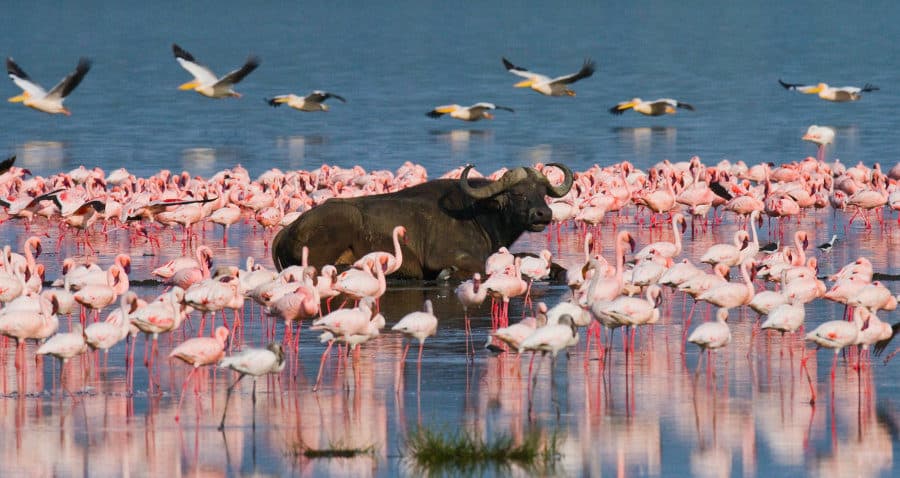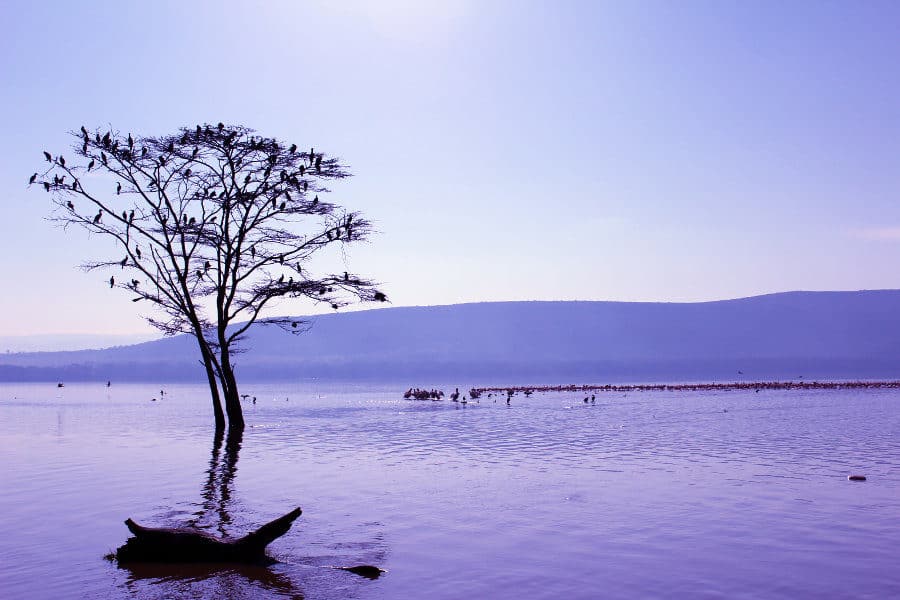Elephants wander beneath Mount Kilimanjaro in Amboseli. Could there be a more iconic safari sight, anywhere in Africa?
Yet this magical sight is just the famous part of the experience. Amboseli National Park is home to a superb array of animals. Best of all, the long dry months make it very easy to view big game.
Amboseli is Kenya’s second most popular safari destination. It’s an ideal first stop if you’ve never been on a safari before, a great chance to witness seasonal change and the rhythm of life.
This article explains everything you need to know to plan a visit to Amboseli National Park.
Where is Amboseli National Park?
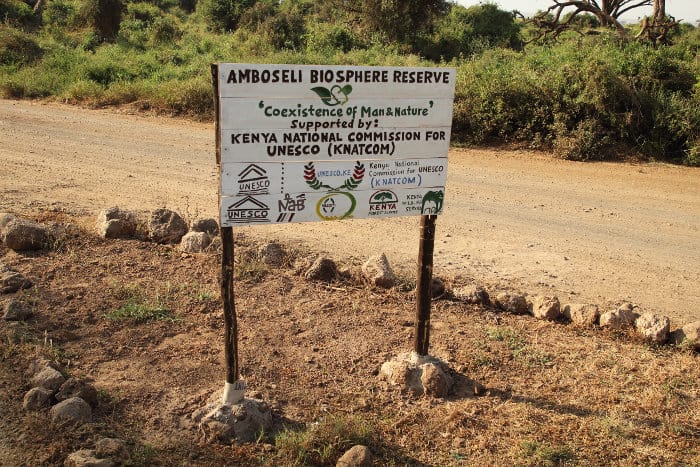
Located in southern Kenya, due east of the Masai Mara, Amboseli is easy to find on a map. Just look for Mount Kilimanjaro, the highest peak in Africa. This great snow-capped mountain is the southern boundary of Amboseli and prevents the animals from migrating into neighbouring Tanzania.
How did Amboseli get its name?
Amboseli is a Masai word that loosely translates as salty dust. This is due to the huge dried-up lake in the centre of the park.
This area has traditionally been the home of Masai tribes, who herded their cattle across the plains. Its original name is Maasai Amboseli Game Reserve. After Amboseli was gazetted as a national park the Masai had to leave. Now they live around the fringes of the park.
What can I do in Amboseli?
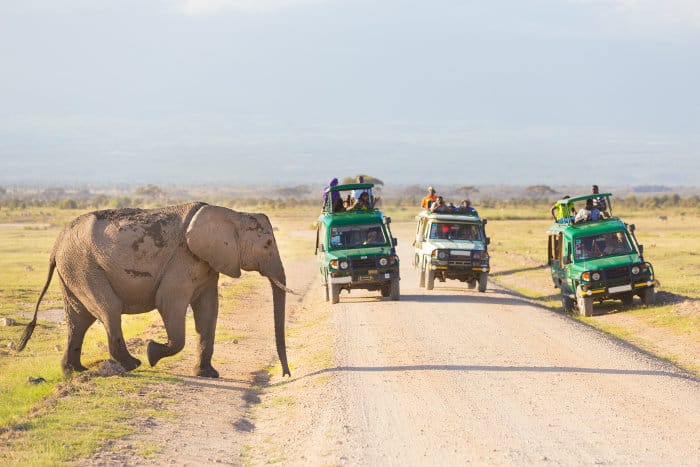
Go on safari and connect with your wild side.
How does Amboseli compare to other safari destinations in East Africa?
Amboseli is one of the most famous parks in East Africa, mostly due to delightful images of elephants with Kilimanjaro in the background.
Let’s compare what it offers with other destinations in East and Southern Africa.
Wildlife – the famous elephants!
The park advertises itself as the best place in Africa to get close to elephant herds. During the 1980s and 1990s tens of thousands of East African elephants were poached for their ivory.
Elephant numbers plummeted in both Kenya and Tanzania. Amboseli was one of the few places that didn’t have a large-scale poaching epidemic. This was partially due to the excellent community charity, the Amboseli Trust for Elephants.
Now there are around 1200 elephants in Amboseli. The population was nearer 2000 but many died during the severe drought of 2008. With few poachers around the elephants have incredible tusks, making the experience even more iconic.
Every visitor to the park enjoys close-up encounters with elephants. 1200 elephants is a lot, considering the park is only 392 square kilometres.
Still, 1200 is nothing like the number of elephants around Chobe in Botswana. It’s not even the most elephants in Kenya; there are 12 000 in Tsavo.
You will see elephants wandering past your camp, across the salty lake bed, and gathering around waterholes.
Big herds are best spotted during the morning and evening, when they wander across the dusty plains. During the day these elephants often relax, semi-submerged, in the Ol Okenya swamp.
It’s more accurate to say that Amboseli is probably the best place to see elephant herds in East Africa.
Wildlife – so much more than elephants
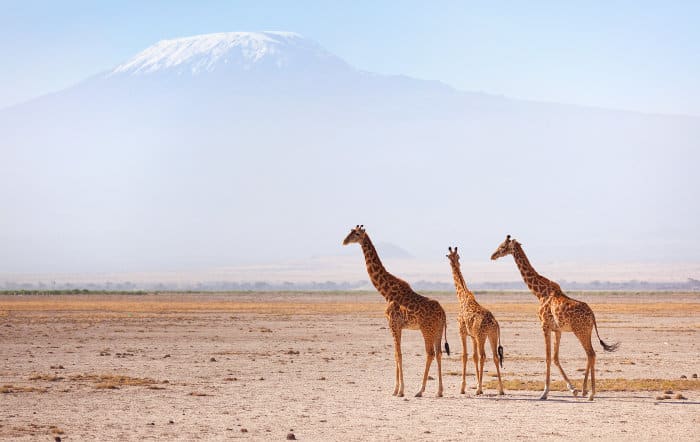
Focusing on elephants means most people are unaware of all the other life that thrives here.
Masai giraffe are as conspicuous as the elephants, either along the horizon or close to an acacia woodland.
Various lion prides roam the park, beneath the shadow of a great mountain. Spotted hyena are the other easy to see predator.
A few cheetah hunt on the open plains, the world’s fastest land mammal usually chasing after impala. However, cheetah are not a common sighting in the park. Leopards are extremely rare as well and spotting one is very unlikely.
Grazing the plains are zebra, wildebeest and buffalo. You’ll see large herds of these, usually so many of them they start blending into the surroundings.
White rhinos are not native to the park. Black rhinos are unfortunately extinct from here, killed off by poaching many decades ago.
Game viewing
Although Amboseli is advertised as a year round destination, there’s a dramatic contrast between the wet and dry seasons.
Game viewing is superb during the dry season, notably from July to October. This is a large open park with very little permanent water. Many of the animals start looking skinny during the dry season as there is very little vegetation around.
With no vegetation the animals gather around the little water that remains, mostly the marshes and five swamps. The animals have nowhere to hide and you can’t really miss them on a safari.
However, the rains bring big change. Amboseli is carpeted in high grass and small waterholes, making it very difficult for game viewing.
Furthermore, many of the trails become inaccessible, so it’s impossible to get around some parts of the park. While the animals may be happier and fatter in the wet season, the game viewing is average during these months.
Price of a safari
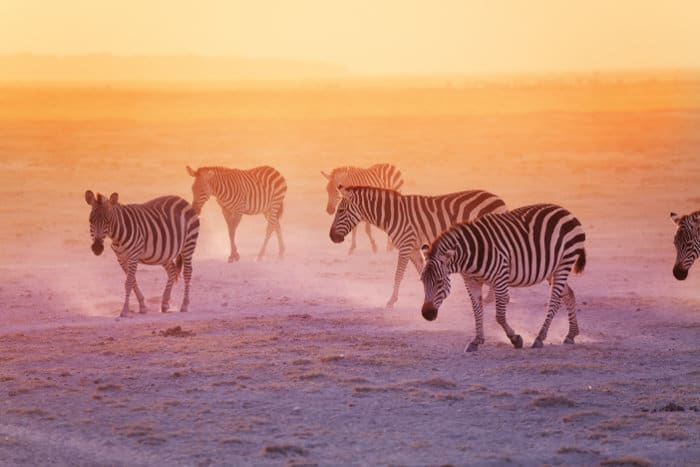
Amboseli safaris are a similar price to Masai Mara safaris, with experiences at both ends of the price spectrum. One of the highlights is that the safari can cater to different budgets and styles.
Budget overland safaris usually depart from Nairobi. They visit Amboseli and maybe Chyulu Hills as well. These can be as low as USD 150 per day and use the park’s public campgrounds.
Nicer camps and lodges are located within the national park, although for these you can expect the safari to cost from USD 400 per day.
Safari experience
The big downside to an Amboseli National Park safari is the number of other people and vehicles. At just 392 square kilometres this is a small park. The most similar park in East Africa is Tarangire in Tanzania, which is more than nine times larger.
The small size is good for encountering big mammals. This is ideal if it’s your first time on a safari. However, many people want to go on their first safari!
During July and August you’ll see as many safari vehicles as elephant herds. There are only a few trails in the parks so vehicles cluster together, particularly around the five main swamps.
There is a private concession for more personal experiences, yet staying here costs close to USD 1000 per day. So if you visit in July and August, Amboseli is a big-game safari with the crowds. Don’t expect to have it all to yourself any month of the year.
If not Amboseli then where to go on safari?
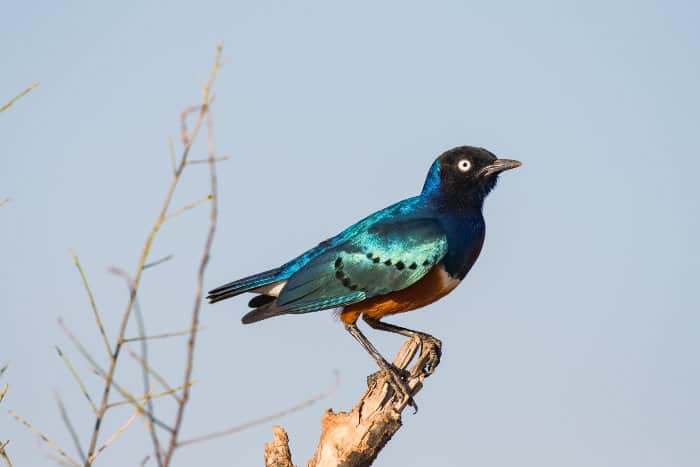
If you seek personal elephant encounters in East Africa then also consider Tarangire in Tanzania.
To get away from the crowds in Kenya try traveling to Samburu, or any of the parks in the Laikipia Plateau. Really, other than Amboseli and the Masai Mara there aren’t many visitors to Kenya’s national parks.
Beyond East Africa then Chobe is recommended for personal moments with elephants, particularly from May to September.
Planning a Safari in Amboseli National Park

Accessibility and traveling to Amboseli
Like all the main East African parks, Amboseli can be visited on a fly-in safari. The long Amboseli airstrip sees flights to and from Nairobi as well as the Masai Mara. During peak season there are flights to Mombasa and other Kenya safari destinations as well.
From Nairobi it’s a four to five hour drive to Amboseli National Park. Unfortunately, traveling between Amboseli and the Masai Mara is a real pain when going by road. You must first backtrack to Nairobi and then continue westwards, a journey that takes over ten hours.
From Amboseli it’s a seven hour drive to Mombasa. And what a drive this is! Passing through Chyulu Hills and Tsavo West, most of the road goes through or alongside national parks.
When to Go
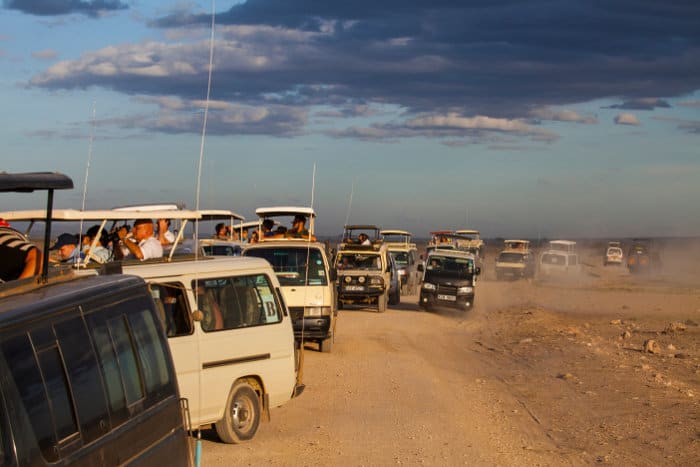
Unfortunately, the best time to visit Amboseli is comfortably the most popular time as well. So the choice is always between better game viewing along with crowds, or average game viewing with less people. Still, there are a couple of prime months to consider.
The main dry season is June to October. These are the best months for game viewing, however, June to August are incredibly busy. September and October are the two best months of the year for a safari in Amboseli, as the dry conditions remain yet there aren’t as many other vehicles.
November and December see some rain and the game viewing is okay.
January to February are vastly underrated. Although the land isn’t in its famous dust-bowl state, you can use these months to avoid crowds and still enjoy plenty of closeup encounters.
Making Amboseli part of a longer safari
The ideal would be to combine Amboseli with the Masai Mara. However, there is no road between these two parks.
Masai Mara and Amboseli is only a realistic itinerary if you are using light aircraft to fly between Kenya’s destinations.
If you don’t mind missing the Masai Mara then this is a much better overland safari route: Nairobi – Amboseli – Chyulu Hills – Tsavo West – Tsavo East – Mombasa. Realistically this would be a one-week safari. It would explore the famous elephants then take you through less popular parks.
Amboseli can also be included in a Kenya plus Tanzania safari. The main road from Nairobi to Arusha passes very close to Amboseli National Park. A nice route would be Nairobi – Amboseli – Lake Manyara, then onwards across Tanzania safari’s northern circuit, such as Ngorongoro and Serengeti.
It’s actually easier to combine Amboseli with the Serengeti than the Masai Mara. You certainly see more along the way. However, do note that safari companies have had some troubles taking their clients across the border.
Where to stay in Amboseli
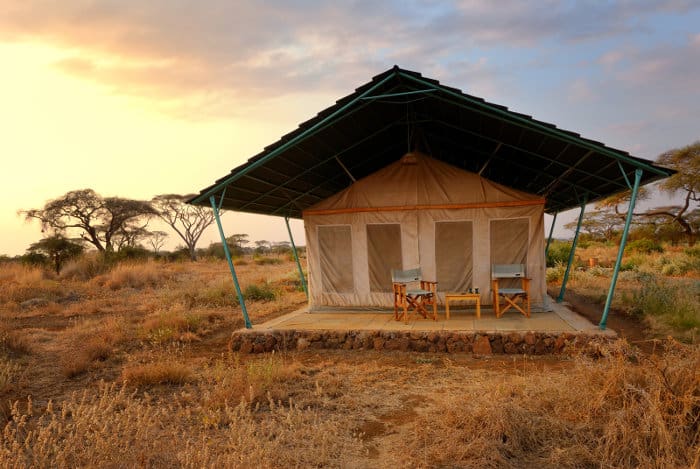
There are a number of decent lodges in the park itself, although many visitors will find them expensive.
Budget safaris use the public campgrounds, which provide dreamy views onto the animals and Mount Kilimanjaro.
Many lodges can be found just outside the park as well. These are cheaper and because the park is so small, you are still pretty close to the wildlife.
Number one tip for a safari in Amboseli National Park
Get up early! That’s tip number one. Most safari destinations are best in the early morning and Amboseli is the park that epitomises this rule.
During morning hours you see large herds of animals on the move. Then during the day most of big animals are trying to stay cool, spotted lazing around one of the swamps. Kilimanjaro is likely to be cloud-free during the early morning as well – it is rarely on show during the afternoon.
Late afternoon and evening safaris provide some dreamy photography, with the circling dust mingling with sunset to produce surreal pink and orange colours.
Take Your Safari Planning Further
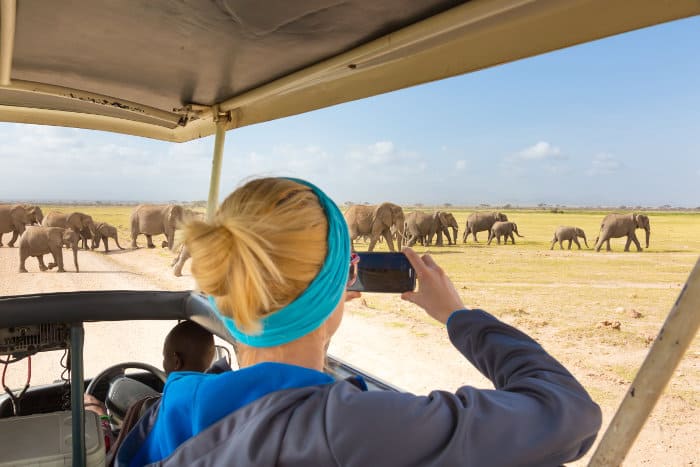
Amboseli is just one famous option for an East Africa safari.
Check out our complete guides to planning a Kenya safari and Tanzania safari. That should give you a lot more inspiration about the possibilities.
If you need individualised advice then we have a partnership with a local African safari operator.
So happy safari, enjoy the elephants in Amboseli, and connect with your wild side. 🙂


